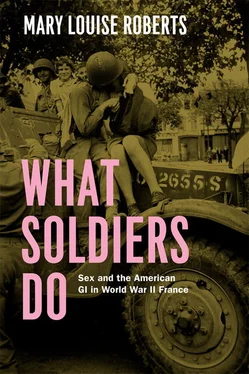One aim of this chapter is to amend that view by revisiting the Normandy campaign as it was seen through French eyes. What was D-day like for the Normans? How did they respond to having their homes, their fields, and their farms turned into a theater of war? Norman accounts of the invasion, recorded in diaries, letters, and memoirs, give us an extraordinarily fresh, vivid account of the months prior to and after the invasion. If Normans appeared to be “ungrateful” and “sullen” to the GIs, as Ambrose believed, they had good reason to be. For them, D-day did not begin on the sixth of June. Rather it started in the fall of 1943, when the Allies initiated preinvasion bombing on northern France. The Normans watched their railways, bridges, workplaces, and homes burn to the ground. For this reason, they dreaded as much as awaited the landings. The war came as a distant thunder, then crashed like an angry storm. As it broke, it produced horrific sights and smells—the rot of animal and human flesh, the stench of death. Normans recounted their encounter with death in a terrible grammar of sounds, sights, smells, and tastes. An estimated 19,890 civilians lost their lives in the Battle of Normandy. During the first two days of the campaign alone, about three thousand were killed—roughly the same number of Allied soldiers killed in that period. 8
Nevertheless the Normans also felt profound gratitude to the Allies for restoring their freedom. However horrible the squall of war, it eventually delivered Americans, with their funny-looking jeeps, their spectacular boots, and their honey-smelling cigarettes. Every Norman remembers the moment when they saw their first American. “We simply did not believe our eyes,” recalled Jacques Perret. “After so many years of occupation, deprivation, alerts, bombings, there were our liberators, ‘our Americans.’” 9Jacques-Alain de Sédouy, a boy of eight in 1944, remembered his first GI in this way: “He could have been a Martian who had fallen out of the sky and we would not have examined him with more curiosity. I could not take my eyes off this man who had come from his distant land in order to liberate France.” 10
Revisiting the campaign from the French side not only gives us a novel, more comprehensive view of the campaign, but also corrects Ambrose’s portrayal of French civilians in three crucial ways. First, far from being traitors or passive by-standers, ordinary Normans readily joined the Allies in their struggle against the Germans. Besides taking up arms, civilians provided crucial intelligence about the terrain and the enemy. They also risked their lives to hide fallen parachutists, harbor stranded infantrymen, and care for the wounded. With very few exceptions, they were comrades and fighters. Second, while there is no question that French civilians welcomed their liberators with wonder and gratitude, it is too simple to portray them as happy celebrants of their own liberation. Although Normans felt enormous relief when the Germans at last departed, they were also forced to endure the war in their own backyard. A fundamental contradiction characterized the Allied mission: the GIs were to both conquer and liberate, demolish and reconstruct. As one journalist said of the civilians in Caen, “their liberators are also destroyers.” 11In this part of France, anger, fear, and loss stripped the moment of its bliss. Liberation was a harrowing experience in which happiness had to share the heart with sorrow. Putting Franco-American relations at the center of the story revises our understanding of the costs paid in the Norman campaign. The Americans did not have a monopoly on suffering, nor did they fight alone.
Lastly, a transatlantic approach alters our view of the American experience in Europe. By focusing on encounters between GIs and civilians, we can appreciate the full extent of the soldiers’ precarious position in the ETO (European theater of operations). Not only were they warriors fighting for their lives, but also strangers in a strange land. An incident recounted by infantryman John Baxter evokes this sense of alienation. One morning, Baxter’s unit drove by convoy through a small village. A French peasant stood and watched them pass through. “We stopped briefly at an intersection and one of our Arkansas soldiers, a man named Mathis, leaned out of the truck and addressed the old man. ‘Hey, Mister!,’ he barked, ‘How far are we from Okalona, Arkansas?’ It broke up the convoy.” 12Mathis’s joke rested not only on the French man’s ignorance of Okalona but also on the idea of the GI as a tourist. It presented the American soldier as a lost traveler trying to find his way home. Unlike tourists to France, the Allies did not expect a warm greeting on Omaha Beach. A good thing, too, as the Germans decidedly did not give them one. But like travelers, they were deposited in an alien landscape, forced to navigate unknown streets, witness unfamiliar customs, and converse with people in a language they did not understand.
The full complexity of the American mission in Europe emerges only when we see the campaign in this way: as an encounter between two allies as well as two enemies. While France was a battlefield, it was also an unknown place, and as such, experienced by GIs in terms not unlike those of a tourist. Such cultural encounters have been overlooked by military historians reluctant to take their eyes off the battlefield. But for millions of GIs, the discovery that a very different world indeed lay beyond the Jersey shore—or San Francisco Bay, for that matter—was central to their war experience. For the GIs, the recognition of cultural difference was unavoidable, astonishing, and often life changing. “From the moment we hit the beaches,” wrote infantryman Aramais Hovsepian to his brothers, “you could tell it was a different country. The air even smelled different!” 13“England was a little like home but France is really a foreign country,” recorded Jan Giles in his diary. 14GI Orval Faubus titled his memoir of France A Faraway Land . With the awareness of difference came the excitement of being in a strange, distant place. Minutes after Charles E. Frohman’s company arrived in Normandy, someone pointed out a French street sign. “Everything else was forgotten in a series of awed Oh’s and Ah’s,” remembered Frohman, who was from Columbus, Ohio. “It was the first distinctly French thing we had ever seen. It looked like something out of a fairy tale book. It just didn’t look real.” 15Like many visitors to France, the GIs peered over maps, babbled in high school French, wondered why the second floor was called the first floor, and stared in utter bewilderment at bidets. 16
The recognition of cultural difference, with its lessons of tolerance and humility, became a legacy of the war for a generation of American men, and thus merits closer historical attention. Thinking about the GI as a tourist can also help to explain the arrogance he often felt toward the French. As soldiers, the Americans bore weapons and wielded enormous power. But as tourists, they were dependent on civilians for local knowledge of geography, language, and customs. In this way, they tacked back and forth between authority and dependence, command and vulnerability. Like many tourists, the GIs dealt with their helplessness by making large (and largely unfounded) generalizations about the French. When in their discomfort Americans succumbed to this reflex to categorize, they made sex the defining element of French civilization.
Countless GIs arrived in Normandy with the notion that France was a playground of easy women and loose morals. Once there, they gave candy to children, shook the hands of young men, learned about the woods from peasants, and saved the lives of old women. In other words, they interacted with civilians in complex, very different ways. At the same time, when confronted with a strange culture, the GIs clung to prejudices they already held about the French. In particular, they focused on French behaviors concerning the body, including public nudity, kissing, and love making. By the end of the summer, the French had become—as an entire people—primitive and oversexed. This view of the Gallic race as uncivilized echoed American imperial thinking in the past. Here it would degrade French efforts to restore an autonomous government, as well as justify US military management in matters of health, sanitation, and transportation.
Читать дальше












